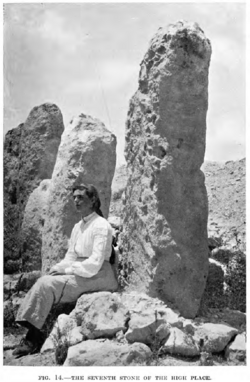Unsolved:Matzevah
Matzevah or masseba[1] (Hebrew: מַצֵּבָה maṣṣēḇā; "pillar") is a term used in the Hebrew Bible for a sacred pillar, a type of standing stone. The term has been adopted by archaeologists for Israelite contexts, seldom for related cultures, such as the Canaanite and the Nabataean ones. As a second derived meaning, it is also used for a headstone or tombstone marking a Jewish grave.
Etymology
The Hebrew word matzevah is derived from a root meaning 'to stand', which led to the meaning of 'pillar'.[2]
The singular form can be found spelled as masseba, maseba, matzevah, matzeva or mazzevah, and the plural form as massebot, masseboth, masebot, matzevot or matzevoth. When used in a Yiddish-influenced context, it can take the form matzeivah.[3]
Biblical narrative
Use of the exclusive word can be found in Genesis 28:18, 28:22, 31:13, 31:45, 35:14, 35:20, Exodus 24:4, Deuteronomy 16:22 and Hosea 3:4.
In Genesis 28:22, Jacob says "and this stone, which I have set up for a matzevah, shall be God's house" and in Genesis 31:13 Yahweh says to Jacob "I am the God of Bethel [lit. "House of God"] where you anointed a matzevah and made a vow to me...".
The matzevah could also serve as a secular memorial: "Jacob set a pillar upon her grave: that is the pillar of Rachel's grave unto this day." (Genesis 35:20) It could also stand as a symbolic witness: upon confronting Jacob in Gilead, Laban declared "This rock-pile is a witness, and this matzevah is a witness, that I will not pass this rock-pile, and you will not pass this rock-pile and this matzevah, for evil." (Genesis 31:52)
Jewish tombstone
Based on Genesis 35:20, observant Jews traditionally erect a monument at the grave of a deceased person.[3] It can be placed either over the grave, as a footstone, or as a headstone.[3]
Three purposes can be distinguished.[3] It may mark the gravesite for purity reasons, as priests (cohanim) are required to avoid defilement through contact with the dead, and a marker (any marker) helps them identify a grave.[3] The name of the deceased written on a stone also allows friends and relatives to identify the grave.[3] A respectable, but unostentatious monument appropriate to heirs' fortune is also a symbolic way to honour the deceased.[3]
See also
- Asherah pole, Canaanite sacred tree or pole honouring Asherah, consort of El
- Baetylus, a type of sacred standing stone
- Bema and bimah, elevated platform
- Ceremonial pole
- High place, raised place of worship
- Lingam, abstract representation of the Hindu god Shiva
- Menhir, orthostat, or standing stone: upright stone, typically from the Bronze Age
- Pole worship
- Stele, stone or wooden slab erected as a monument
References
- ↑ Oxford Biblical Studies Online, Oxford University Press. Accessed 14 February 2022.
- ↑ Tombstone. Oxford University Press. 1999. ISBN 9780192800886. https://www.oxfordreference.com/view/10.1093/acref/9780192800886.001.0001/acref-9780192800886-e-714. Retrieved 17 January 2022.
- ↑ 3.0 3.1 3.2 3.3 3.4 3.5 3.6 The Monument ("Matzeivah"), Maurice Lamm for Chabad.org. Accessed 17 Jan 2022.
External links
- "matzeva" at Encyclopædia Britannica online
 |


